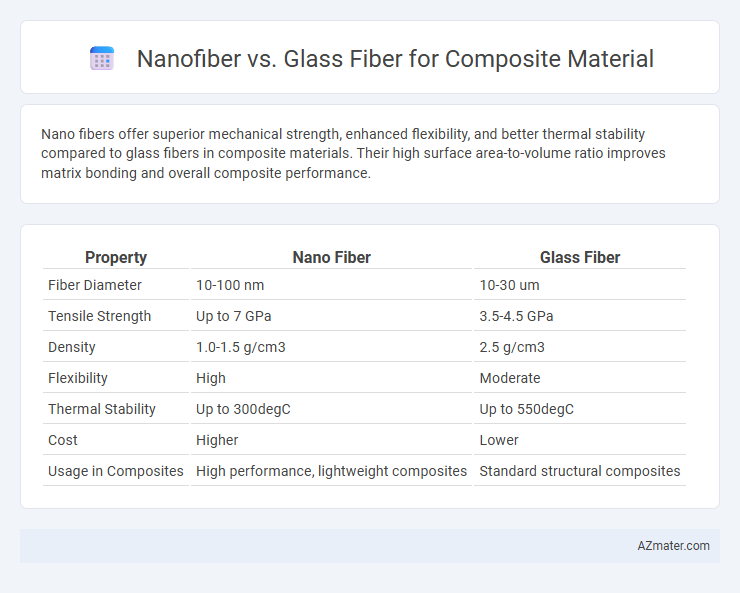Nano fibers offer superior mechanical strength, enhanced flexibility, and better thermal stability compared to glass fibers in composite materials. Their high surface area-to-volume ratio improves matrix bonding and overall composite performance.
Table of Comparison
| Property | Nano Fiber | Glass Fiber |
|---|---|---|
| Fiber Diameter | 10-100 nm | 10-30 um |
| Tensile Strength | Up to 7 GPa | 3.5-4.5 GPa |
| Density | 1.0-1.5 g/cm3 | 2.5 g/cm3 |
| Flexibility | High | Moderate |
| Thermal Stability | Up to 300degC | Up to 550degC |
| Cost | Higher | Lower |
| Usage in Composites | High performance, lightweight composites | Standard structural composites |
Introduction to Composite Materials
Nanofiber and glass fiber each serve distinct roles in composite materials, influencing mechanical properties and application performance. Nanofibers, with diameters in the nanometer range, provide exceptional surface area and enhanced interfacial bonding, which improves tensile strength and stiffness in composites. Glass fibers, renowned for their high tensile strength, chemical resistance, and cost-effectiveness, are widely used to reinforce polymers in aerospace, automotive, and construction industries.
Overview of Nano Fibers
Nano fibers exhibit exceptional mechanical properties, including high tensile strength and flexibility, due to their ultra-fine diameter and large surface area. These fibers enhance composite materials by improving interfacial bonding and providing superior resistance to damage and fatigue compared to traditional glass fibers. Their nanoscale dimensions enable the development of lightweight, high-performance composites ideal for aerospace, automotive, and biomedical applications.
Overview of Glass Fibers
Glass fibers, a widely used reinforcement in composite materials, offer excellent tensile strength, high chemical resistance, and thermal stability, making them ideal for automotive, aerospace, and construction applications. Their relatively low cost and ease of processing contribute to widespread adoption, although they are heavier and less flexible compared to nano fibers. Glass fibers provide reliable stiffness and durability, ensuring enhanced mechanical performance in composite structures.
Mechanical Properties Comparison
Nanofibers exhibit significantly higher tensile strength and modulus compared to glass fibers due to their ultra-fine diameter and enhanced surface area, which improve stress transfer within composite materials. Nanofiber-reinforced composites demonstrate superior impact resistance and fatigue durability, offering enhanced mechanical performance under cyclic loading conditions. Glass fibers still provide higher compressive strength and are more cost-effective, but nanofibers excel in stiffness-to-weight ratio and toughness, making them ideal for high-performance applications.
Weight and Density Analysis
Nano fiber composites exhibit significantly lower weight and density compared to glass fiber composites due to nanoscale fiber dimensions and higher surface area-to-volume ratio, enhancing material strength without added mass. Glass fiber composites typically have a density around 2.5 g/cm3, whereas nano fiber composites can achieve densities below 1.5 g/cm3, optimizing lightweight applications in aerospace and automotive industries. The reduced density of nano fiber composites directly contributes to improved fuel efficiency and structural performance by minimizing overall component weight.
Durability and Fatigue Resistance
Nanofiber composites exhibit superior durability and fatigue resistance compared to glass fiber composites due to their high surface area to volume ratio and enhanced interfacial bonding with the matrix. This results in improved crack resistance and energy dissipation under cyclic loading, extending the material's service life. Glass fiber composites, while economically advantageous, generally demonstrate lower fatigue performance and are more prone to micro-cracking and delamination over prolonged stress cycles.
Cost and Manufacturing Considerations
Nano fiber composites generally incur higher manufacturing costs due to specialized equipment and precise processing conditions required for nanoscale material integration, contrasting with glass fiber composites that utilize established, cost-effective production methods like filament winding and hand lay-up. Glass fibers offer scalability and ease of fabrication, significantly reducing labor and material expenses, making them more economically viable for large-scale applications. While nano fibers provide superior mechanical properties and lightweight advantages, their cost-intensive production limits widespread adoption compared to the budget-friendly manufacturing and availability of glass fiber composites.
Applications in Industry
Nanofiber composites offer superior mechanical strength, enhanced thermal stability, and improved chemical resistance, making them ideal for aerospace, electronics, and biomedical industries where high performance and lightweight materials are critical. Glass fiber composites provide excellent cost-efficiency, corrosion resistance, and good tensile strength, widely used in automotive, marine, and construction sectors for structural reinforcement and insulation purposes. Industrial applications leverage nanofibers for precision components and advanced filtration, while glass fibers dominate large-scale manufacturing due to their scalability and economic benefits.
Environmental Impact and Sustainability
Nano fiber composites offer enhanced environmental sustainability due to their reduced material usage, lower energy consumption during production, and potential for biodegradability compared to traditional glass fiber composites. Glass fiber composites typically involve higher carbon footprints because of energy-intensive manufacturing processes and challenges in recyclability, leading to greater environmental impact. The shift toward nano fiber materials supports the development of greener composites by enabling lighter, stronger products with improved lifecycle performance and reduced waste generation.
Future Trends in Composite Fiber Materials
Nanofibers offer superior mechanical properties, enhanced surface area, and improved interfacial bonding compared to traditional glass fibers, positioning them as a transformative option in future composite materials. Advanced nanofiber composites enable lightweight, high-strength, and multifunctional applications in aerospace, automotive, and biomedical industries. Ongoing research prioritizes scalable manufacturing techniques, functionalization of nanofibers, and hybrid composites to optimize performance and sustainability in emerging composite technologies.

Infographic: Nano fiber vs Glass fiber for Composite material
 azmater.com
azmater.com